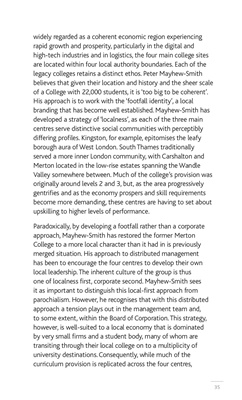
35
widely regarded as a coherent economic region experiencing
rapid growth and prosperity, particularly in the digital and
high-tech industries and in logistics, the four main college sites
are located within four local authority boundaries. Each of the
legacy colleges retains a distinct ethos. Peter Mayhew-Smith
believes that given their location and history and the sheer scale
of a College with 22,000 students, it is 'too big to be coherent'.
His approach is to work with the 'footfall identity', a local
branding that has become well established. Mayhew-Smith has
developed a strategy of 'localness', as each of the three main
centres serve distinctive social communities with perceptibly
differing profiles. Kingston, for example, epitomises the leafy
borough aura of West London. South Thames traditionally
served a more inner London community, with Carshalton and
Merton located in the low-rise estates spanning the Wandle
Valley somewhere between. Much of the college's provision was
originally around levels 2 and 3, but, as the area progressively
gentrifies and as the economy prospers and skill requirements
become more demanding, these centres are having to set about
upskilling to higher levels of performance.
Paradoxically, by developing a footfall rather than a corporate
approach, Mayhew-Smith has restored the former Merton
College to a more local character than it had in is previously
merged situation. His approach to distributed management
has been to encourage the four centres to develop their own
local leadership. The inherent culture of the group is thus
one of localness first, corporate second. Mayhew-Smith sees
it as important to distinguish this local-first approach from
parochialism. However, he recognises that with this distributed
approach a tension plays out in the management team and,
to some extent, within the Board of Corporation. This strategy,
however, is well-suited to a local economy that is dominated
by very small firms and a student body, many of whom are
transiting through their local college on to a multiplicity of
university destinations. Consequently, while much of the
curriculum provision is replicated across the four centres,